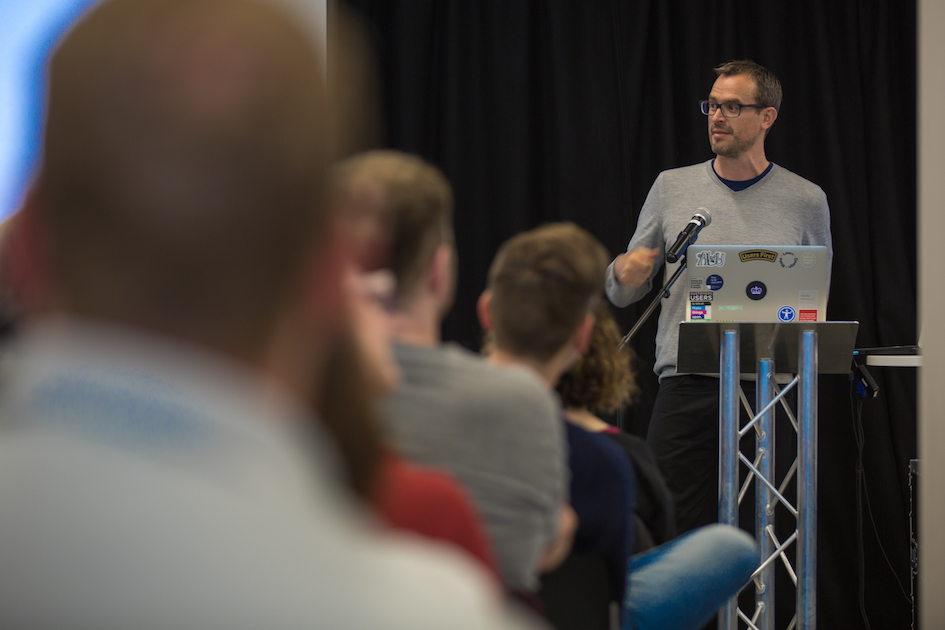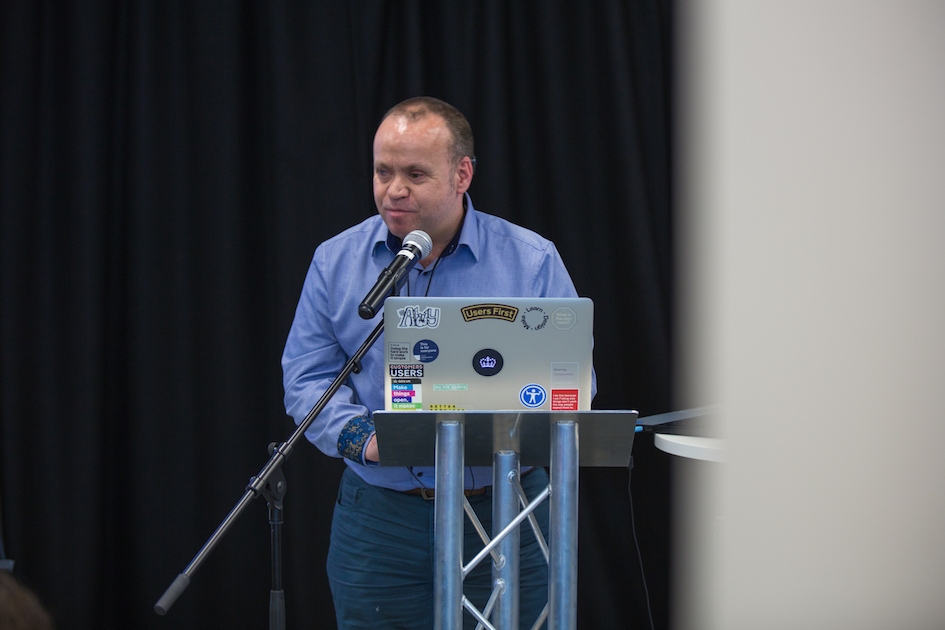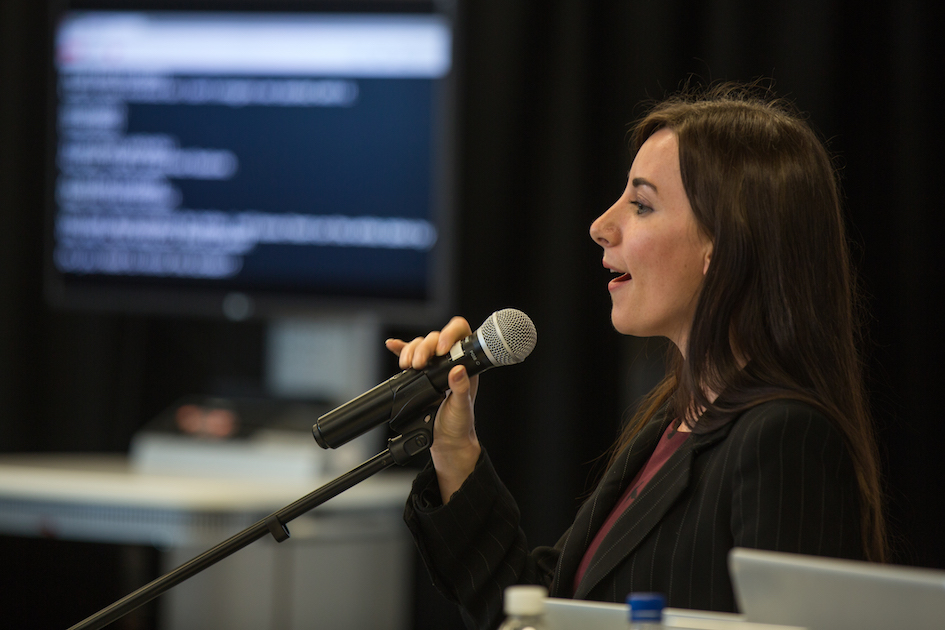
Earlier this year we held the fourth Cross-Government Accessibility Meetup. It was the biggest event so far, with more than 150 people joining us in Newcastle.
We held the meetup on 18 May, which was also Global Accessibility Awareness Day. Here’s what we talked about:
Approaching accessibility at HMRC

Our first speaker was Chris Moore, accessibility champion at HMRC. Chris is both deaf and blind and has previously talked to us about his experiences using technology. Under Chris’s leadership, the HMRC team were recognised in the recent Heroes of Accessibility Awards.
Chris talked about HMRC’s ambition to be an accessible organisation by default. He talked about how he has worked with different disciplines across HMRC, including designers and developers, to raise awareness of accessibility. How he has worked to “get people on the accessibility bus”.
Chris also talked about how the accessibility community has helped all departments start to think about the issue: “We need to solve accessibility as government”.
User research with people with access needs
Our next speakers were James Buller and Kate Shipp, who are both user researchers at the Home Office. They spoke about the importance of user testing with users with access needs and how they go about recruiting these users.
Some of their tips for recruiting internal users were:
- work with internal networks - James and Kate linked in with the Home Office’s internal staff disability network
- use directory groups - if organisations use assistive technology they will need licences for this, therefore there will be an active directory group of the people using that technology
- use other people as diversity and inclusion champions in the organisation - they can put you in touch with people who have access needs
- use internal resources such as intranets and newsletters - as well as posters and leaflets
And some tips for recruiting external users:
- approach external organisations such as charities, support groups and patient groups
- talk directly to groups - not through an intermediary
- use recruitment agencies
- talk to all your user research participants to find out if they have access needs - you could use a monitoring form or just ask people at the start of the session
James and Kate also talked about the importance of training user researchers to run sessions with people with access needs and the importance of keeping track of all the research participants you work with.
Making the country and territory picker component accessible
Ed Horsford, Rob Le Quesne and Theo Vararu from GDS talked about the work they’ve done to make the country and territory picker autocomplete component as accessible as possible.
Most existing autocompletes are not always compatible with assistive technology like screenreaders and speech recognition software. The team talked about how they’ve built on the work Home Office and DWP have already done on their autocomplete.
They demoed the component and talked about how they carried out testing at the Digital Accessibility Centre, where they worked with testers using screenreaders and speech recognition software.
Accessing services as a deaf person

We also heard from Ruth MacMullen, who is a librarian at York St John University. Ruth has been profoundly deaf since birth and has used cochlear implants since she was 13. Ruth talked about her day-to-day experiences being deaf, as well as how it affected her as a service user.
She said the experience of deafness can be frustrating, because there’s a sense of missing out, and confusing and disorienting, particularly when you’re in a new place for the first time. She also said that deafness can be quite a noisy experience - because many deaf people wear hearing equipment that can amplify sounds such as a teacup clinking.
Because deafness isn’t a visible condition, Ruth said that even people who have known her for a long time might not remember she is deaf and can forget to do the things that will help her.
Ruth said it’s important for organisations to think about the range of needs that deaf users (and others) might have, and to plan for these. She said: ‘Accessibility rarely happens by chance. You need structures in order for it to take place in the first place.’
Web accessibility for people who are hard of hearing
Ruth was followed by David Swallow, a consultant at the Paciello Group, who spoke about how to make the web accessible for people who are hard of hearing.
He talked about the importance not just of using captions for audio, but for making those captions as accurate and closely synchronised to the audio as possible. He also talked about how important it is to provide a full and accurate summary of audio and video content, so that people who are hard of hearing are aware of what the content is.
And he talked about how important it is not to autoplay audio - as this can result in people who are hard of hearing inadvertently playing loud audio. He showed the example of a hotel website in Germany that booms out Shostakovich when it has loaded.
Creating an inclusive environment for people who are deaf and use BSL

The final speaker was Laura Andrews, who is a service designer at Citizens Advice (CA). She spoke about the work CA has been doing to create an inclusive environment for deaf people at the organisation.
Improving access for deaf people is one of the aims in CA’s equality strategy and the organisation is running a 2-year pilot delivering advice to deaf people through deaf advisors.
Laura talked about how time-related performance targets for advisors can inadvertently deter deaf people from getting support, because they can take longer to help. She said: “This can result in a poor client experience because the deaf client can feel they are being rushed and they cannot take the information in.”
She also talked about how important it is to make the full service journey accessible - from the very first step, which is often finding support and information about services.
Come to our next meetup
Our next Cross-Government Accessibility Meetup will be held on 31 October in London. Join the Accessibility Community to find out more.


1 comment
Comment by Charlotte Smith posted on
I am a deaf employee with other disabilities. I dont use BSL so it is not obvious to others that i am deaf. One of the best things in recent years was me getting a Phonak Roger Pen to amplify my phone and take into meetings with me as well. It has made a world of difference. I did have to fight tooth and nail to get it though.
I just wish i could afford to buy one for use at home away from work. But unfortunately PIP decided i was not disabled enough despite having multiple disabilities since birth.